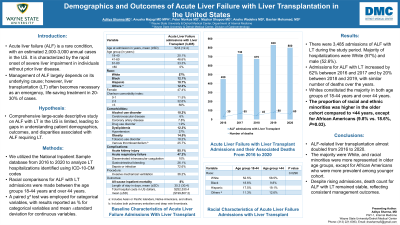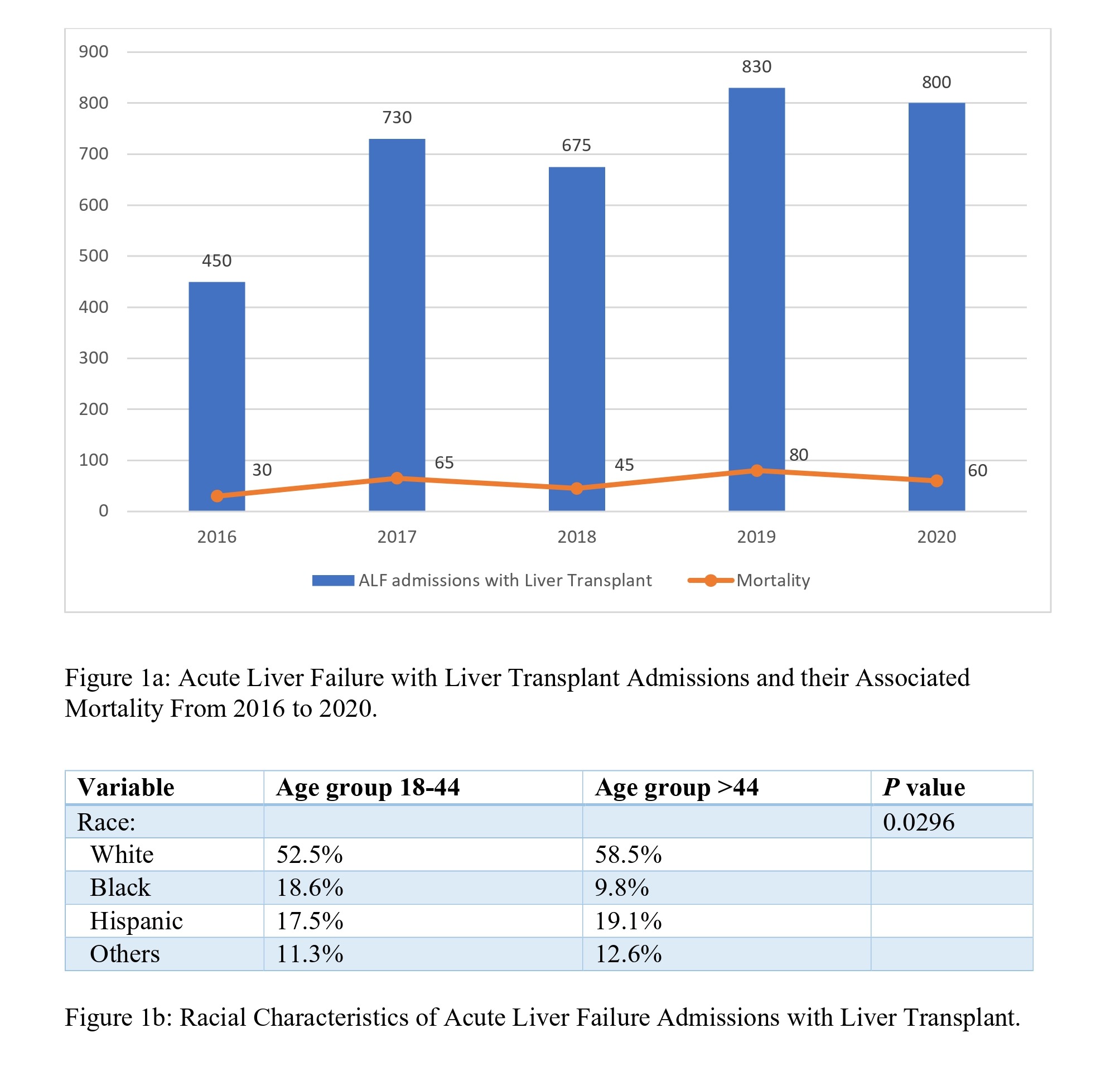Sunday Poster Session
Category: Liver
P1237 - Demographics and Outcomes of Acute Liver Failure with Liver Transplantation in the United States.
Sunday, October 27, 2024
3:30 PM - 7:00 PM ET
Location: Exhibit Hall E

Has Audio

Aditya Sharma, MD
Detroit Medical Center/Wayne State University
Detroit, MI
Presenting Author(s)
Aditya Sharma, MD1, Anusha Majagi, MD1, Peter Morkos, MD1, Mazhar Shapoo, MD2, Anshu Wadehra, MD1, Bashar Mohamad, MD3
1Detroit Medical Center/Wayne State University, Detroit, MI; 2Wayne State University/DMC, Detroit, MI; 3Wayne State University, Detroit, MI
Introduction: Acute liver failure (ALF) is a rare condition, with an estimated 2,000-3,000 annual cases in United States (US). It is characterized by the rapid onset of severe liver impairment in individuals without prior liver disease. Management of ALF largely depends on its underlying cause; however, liver transplantation (LT) often becomes necessary as an emergency, life-saving treatment in 20-30% of cases. Significant improvements have been made in survival rates following LT for ALF. However, comprehensive large-scale descriptive data on ALF with LT in US remains limited.
Methods: The study utilized the NIS database from 2016 to 2020 to analyze LT hospitalizations identified using International Classification of Diseases, Tenth Revision, Procedure Coding System codes and ALF admissions identified using International Classification of Diseases, Tenth Revision, Clinical Modification (ICD-10-CM) codes. Baseline variables, including demographic-characteristics, hospital-characteristics, comorbidities, and complications, were analyzed using ICD-10 codes. Racial comparisons for ALF with LT admissions were made between the age groups 18-44 years and over 44 years. A paired χ² test was employed for categorical variables, with results reported as % for categorical variables and mean ±standard deviation for continuous variables.
Results: There were 3,485 admissions of ALF with LT during the study period. The majority of hospitalizations were White (57%) and male (52.6%). Comorbidities such as alcohol use disorder (10.2%), drug use disorder (1.9%), obesity (14.5%), and dyslipidemia (12.3%) were associated with more than one third of the total admissions. The most common complications associated with these hospitalizations were acute kidney injury (85.1%) and sepsis or infection (72.6%). Admissions for ALF with LT increased by 62% between 2016 and 2017 and by 20% between 2018 and 2019, with similar mortality over the years. While Whites constituted the majority in both age groups, the proportion of racial and ethnic minorities was higher in the older cohort compared to < 44 years, except for African Americans (9.8% vs. 18.6%, P=0.03).
Discussion: This is one of the first studies to evaluate descriptive characteristics for admissions of ALF with LT in the US over the course of 5 years. These admissions are overall increasing, consistent with the national trend of overall LTs. Further investigation is warranted to assess the underlying causes of ALF requiring LTs and disparities related to race and age.

Note: The table for this abstract can be viewed in the ePoster Gallery section of the ACG 2024 ePoster Site or in The American Journal of Gastroenterology's abstract supplement issue, both of which will be available starting October 27, 2024.
Disclosures:
Aditya Sharma, MD1, Anusha Majagi, MD1, Peter Morkos, MD1, Mazhar Shapoo, MD2, Anshu Wadehra, MD1, Bashar Mohamad, MD3. P1237 - Demographics and Outcomes of Acute Liver Failure with Liver Transplantation in the United States., ACG 2024 Annual Scientific Meeting Abstracts. Philadelphia, PA: American College of Gastroenterology.
1Detroit Medical Center/Wayne State University, Detroit, MI; 2Wayne State University/DMC, Detroit, MI; 3Wayne State University, Detroit, MI
Introduction: Acute liver failure (ALF) is a rare condition, with an estimated 2,000-3,000 annual cases in United States (US). It is characterized by the rapid onset of severe liver impairment in individuals without prior liver disease. Management of ALF largely depends on its underlying cause; however, liver transplantation (LT) often becomes necessary as an emergency, life-saving treatment in 20-30% of cases. Significant improvements have been made in survival rates following LT for ALF. However, comprehensive large-scale descriptive data on ALF with LT in US remains limited.
Methods: The study utilized the NIS database from 2016 to 2020 to analyze LT hospitalizations identified using International Classification of Diseases, Tenth Revision, Procedure Coding System codes and ALF admissions identified using International Classification of Diseases, Tenth Revision, Clinical Modification (ICD-10-CM) codes. Baseline variables, including demographic-characteristics, hospital-characteristics, comorbidities, and complications, were analyzed using ICD-10 codes. Racial comparisons for ALF with LT admissions were made between the age groups 18-44 years and over 44 years. A paired χ² test was employed for categorical variables, with results reported as % for categorical variables and mean ±standard deviation for continuous variables.
Results: There were 3,485 admissions of ALF with LT during the study period. The majority of hospitalizations were White (57%) and male (52.6%). Comorbidities such as alcohol use disorder (10.2%), drug use disorder (1.9%), obesity (14.5%), and dyslipidemia (12.3%) were associated with more than one third of the total admissions. The most common complications associated with these hospitalizations were acute kidney injury (85.1%) and sepsis or infection (72.6%). Admissions for ALF with LT increased by 62% between 2016 and 2017 and by 20% between 2018 and 2019, with similar mortality over the years. While Whites constituted the majority in both age groups, the proportion of racial and ethnic minorities was higher in the older cohort compared to < 44 years, except for African Americans (9.8% vs. 18.6%, P=0.03).
Discussion: This is one of the first studies to evaluate descriptive characteristics for admissions of ALF with LT in the US over the course of 5 years. These admissions are overall increasing, consistent with the national trend of overall LTs. Further investigation is warranted to assess the underlying causes of ALF requiring LTs and disparities related to race and age.

Figure: Mortality and Racial Characteristics Associated with Acute Liver Failure and Liver Transplant Admissions from 2016 to 2020
Note: The table for this abstract can be viewed in the ePoster Gallery section of the ACG 2024 ePoster Site or in The American Journal of Gastroenterology's abstract supplement issue, both of which will be available starting October 27, 2024.
Disclosures:
Aditya Sharma indicated no relevant financial relationships.
Anusha Majagi indicated no relevant financial relationships.
Peter Morkos indicated no relevant financial relationships.
Mazhar Shapoo indicated no relevant financial relationships.
Anshu Wadehra indicated no relevant financial relationships.
Bashar Mohamad indicated no relevant financial relationships.
Aditya Sharma, MD1, Anusha Majagi, MD1, Peter Morkos, MD1, Mazhar Shapoo, MD2, Anshu Wadehra, MD1, Bashar Mohamad, MD3. P1237 - Demographics and Outcomes of Acute Liver Failure with Liver Transplantation in the United States., ACG 2024 Annual Scientific Meeting Abstracts. Philadelphia, PA: American College of Gastroenterology.

